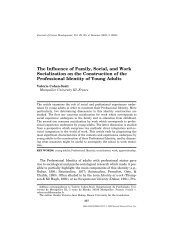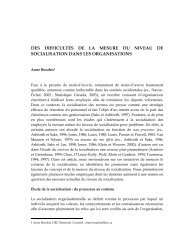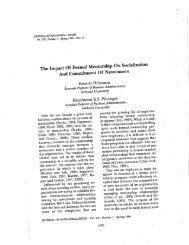Training in the 21st Century: Some Lessons from the Last One - Free
Training in the 21st Century: Some Lessons from the Last One - Free
Training in the 21st Century: Some Lessons from the Last One - Free
Create successful ePaper yourself
Turn your PDF publications into a flip-book with our unique Google optimized e-Paper software.
40 Haccoun and Saks<br />
Tim<strong>in</strong>g of<br />
Intervention<br />
Pre-<strong>Tra<strong>in</strong><strong>in</strong>g</strong><br />
Dur<strong>in</strong>g<br />
<strong>Tra<strong>in</strong><strong>in</strong>g</strong><br />
Post-<br />
<strong>Tra<strong>in</strong><strong>in</strong>g</strong><br />
Mastery<br />
Experiences<br />
Rgnre 1. Sources of Self-Efficacy x Tim<strong>in</strong>g of Intervention Framework<br />
effectiveness of tra<strong>in</strong><strong>in</strong>g, tra<strong>in</strong>ers need <strong>in</strong>formation on<br />
how and when to <strong>in</strong>crease tra<strong>in</strong>ee self-efficacy. This could<br />
be partly achieved through <strong>the</strong> use of a self-efficacy<br />
<strong>in</strong>tervention framework.<br />
Setfefficocy <strong>in</strong>tervention framework. Figures 1 and 2 present<br />
a self-efficacy <strong>in</strong>tervention framework that can be used as<br />
a guide for tra<strong>in</strong>ers and a basis for future research on<br />
self-efficacy and tra<strong>in</strong><strong>in</strong>g. The first major component of<br />
<strong>the</strong> framework deals with how to streng<strong>the</strong>n tra<strong>in</strong>ee selfefficacy.<br />
Accord<strong>in</strong>g to Bandura (1997), <strong>the</strong>re are four<br />
major sources of self-efficacy <strong>in</strong>formation <strong>from</strong> which<br />
one may draw upon to <strong>in</strong>crease self-efficacy (mastery<br />
experiences, vicarious learn<strong>in</strong>g, verbal persuasion, and<br />
physiological state). Thus, tra<strong>in</strong>ers can <strong>in</strong>fluence tra<strong>in</strong>ee<br />
self-efficacy by provid<strong>in</strong>g tra<strong>in</strong>ees with opportunities to<br />
successfully perform tra<strong>in</strong><strong>in</strong>g tasks, by us<strong>in</strong>g role models<br />
perform<strong>in</strong>g tra<strong>in</strong><strong>in</strong>g tasks, by provid<strong>in</strong>g positive and<br />
encourag<strong>in</strong>g feedback, and by calm<strong>in</strong>g tra<strong>in</strong>ee fears and<br />
anxiety about die tra<strong>in</strong><strong>in</strong>g task and transfer.<br />
The second major component of <strong>the</strong> framework deals<br />
with when to streng<strong>the</strong>n tra<strong>in</strong>ee self-efficacy. The transfer<br />
literature has identified diree ma<strong>in</strong> <strong>in</strong>tervals when<br />
transfer <strong>in</strong>terventions can be used (Broad & Newstrom,<br />
1992; Tannenbaum & Yukl, 1992). A similar approach<br />
can be applied for streng<strong>the</strong>n<strong>in</strong>g tra<strong>in</strong>ee self-efficacy.<br />
That is, Bandura's (1997) four sources of self-efficacy<br />
<strong>in</strong>formation can be <strong>in</strong>tegrated <strong>in</strong>to <strong>the</strong> tra<strong>in</strong><strong>in</strong>g process<br />
before die tra<strong>in</strong><strong>in</strong>g program commences (i.e., pretra<strong>in</strong><strong>in</strong>g),<br />
dur<strong>in</strong>g <strong>the</strong> tra<strong>in</strong><strong>in</strong>g program (dur<strong>in</strong>g learn<strong>in</strong>g<br />
and practice), and/or after <strong>the</strong> tra<strong>in</strong><strong>in</strong>g program (i.e.,<br />
post-tra<strong>in</strong><strong>in</strong>g). As <strong>in</strong>dicated <strong>in</strong> Figure 1, by cross<strong>in</strong>g <strong>the</strong>se<br />
three time <strong>in</strong>tervals widi Bandura's (1997) four sources<br />
of self-efficacy <strong>in</strong>formation, one has a 4 (self-efficacy<br />
source) by 3 (tra<strong>in</strong><strong>in</strong>g <strong>in</strong>terval) framework of how and<br />
when to <strong>in</strong>tervene to <strong>in</strong>crease tra<strong>in</strong>ee self-efficacy.<br />
/<br />
Sources of Self-Efficacy<br />
Vicarious<br />
Learn<strong>in</strong>g<br />
/<br />
Verbal Persuasion<br />
/<br />
V<br />
Physiological<br />
State<br />
Streng<strong>the</strong>n<strong>in</strong>g self-efficacy prior to and after tra<strong>in</strong><strong>in</strong>g is<br />
most likely to be accomplished dirough verbal persuasion<br />
and physiological state, while mastery experiences<br />
and vicarious learn<strong>in</strong>g are likely to be <strong>the</strong> best sources<br />
dur<strong>in</strong>g tra<strong>in</strong><strong>in</strong>g.<br />
F<strong>in</strong>ally, know<strong>in</strong>g how and when to <strong>in</strong>crease tra<strong>in</strong>ee selfefficacy<br />
is likely to depend on a number of key factors <strong>in</strong><br />
die tra<strong>in</strong><strong>in</strong>g process or tra<strong>in</strong><strong>in</strong>g factors. Therefore, <strong>the</strong><br />
diird major component of <strong>the</strong> framework deals with four<br />
such variables: 1. tra<strong>in</strong>ee characteristics and <strong>in</strong>dividual<br />
differences (e.g., pretra<strong>in</strong><strong>in</strong>gself-efficacy); 2. <strong>the</strong> tra<strong>in</strong><strong>in</strong>g<br />
mediod (e.g., structured versus unstructured); 3. die<br />
tra<strong>in</strong><strong>in</strong>g content (e.g., simple versus novel or complex);<br />
and 4. <strong>the</strong> organization environment (supportive versus<br />
nonsupportive). As <strong>in</strong>dicated <strong>in</strong> Figure 2, <strong>in</strong>terventions<br />
for <strong>in</strong>creas<strong>in</strong>g tra<strong>in</strong>ee self-efficacy will be most important<br />
when tra<strong>in</strong>ees have low pretra<strong>in</strong><strong>in</strong>g self-efficacy, die<br />
tra<strong>in</strong><strong>in</strong>g task is unstructured, <strong>the</strong> tra<strong>in</strong><strong>in</strong>g content is<br />
complex, and when diere is little social support <strong>in</strong> die<br />
work environment (Saks, 1997). Increas<strong>in</strong>g self-efficacy<br />
prior to and dur<strong>in</strong>g tra<strong>in</strong><strong>in</strong>g will be most important when<br />
tra<strong>in</strong>ees have low self-efficacy to learn and to master die<br />
tra<strong>in</strong><strong>in</strong>g content, and when <strong>the</strong> tra<strong>in</strong><strong>in</strong>g mediod is<br />
unstructured and die content is novel or complex. Posttra<strong>in</strong><strong>in</strong>g<br />
<strong>in</strong>terventions will be necessary when tra<strong>in</strong>ees<br />
have low self-efficacy to transfer and to overcome environmental<br />
obstacles.<br />
Aldiough future research is needed to exam<strong>in</strong>e diese<br />
factors <strong>in</strong> test<strong>in</strong>g die effects of various <strong>in</strong>terventions<br />
designed to strengdien tra<strong>in</strong>ee self-efficacy, die framework<br />
can provide tra<strong>in</strong>ers a guide as diey approach each<br />
tra<strong>in</strong><strong>in</strong>g situation by ask<strong>in</strong>g diree general questions:<br />
V<br />
/<br />
1. What is <strong>the</strong> best approach for streng<strong>the</strong>n<strong>in</strong>g tra<strong>in</strong>ee self-efficacy<br />
(mastery experiences, vicarious learn<strong>in</strong>g, verbal persuasion,<br />
and/or physiological state)?





